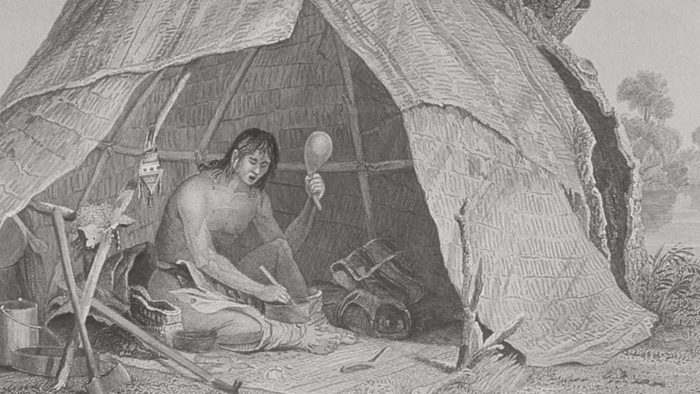
25 Sep Medicinal Plants of the Native Americans
When arriving in America, English colonists were frightened by the medicine of the Native Americans, whom they referred to as the ‘Redskins’.
The Natives’ use of medicinal and aromatic plants played a role in shamanism, healing rites and other forms of religious practices, which of course frightened the colonists, who claimed Native medicine to be diabolical. And so to heal themselves, the new settlers tried to bring in European medicinal plants to the new continent. However, those who mustered the courage to try Native medicinal practices soon realised their effectiveness.
Three centuries later, an unorthodox herbal practitioner, Samuel Thompson [1769-1843], became interested in the medicinal plants of the Native Americans, and claimed to have ‘invented’ a new discipline—physiomedicalism. As the son of a poor and illiterate farmer from Alstead, New Hampshire, Thompson’s aim was to make a fortune, and he claimed to have developed a ‘curative regime’ based on emetic substances (which cause vomiting), purgatives (which drain the intestines), stimulants as well as steam baths. Thompson kept his ingredients a secret, however they were all Native American plants and included:
- Lobelia (Lobelia inflate) – Lobelia was very popular among the Native Americans, who ranked it high in their materia medica. It was used as a relaxant, especially during labour, an expectorant and an emetic. Thompson made Lobelia famous and claimed that “the Emetic herb . . . is the most important article I make use of in my practice.”
- Echinacea species – There are nine species of Echinacea, four of which are used medicinally and which stimulate the immune system. Echinacea species were historically used by the Natives to treat infections and wounds, and were known to be a general ‘cure-all’.
- Goldenseal (Hydrastis canadensis) – Goldenseal is used as a tonic and includes anti-tumour, anti-microbial and anti-inflammatory properties. The Natives historically used the plant for various health concerns, including skin diseases, ulcer symptoms and gonorrhoea. They introduced the powers of the plant to European colonists to treat eye, skin and digestive issues. They also mixed goldenseal with bear grease to use as an insect repellent as well as its colour-rich roots to dye clothing.
- White Helleborine (Veratrum album) – White Helleborine with its purgative virtues, played an essential role in some Native American ceremonies, including shamanic healing, festivals, tribal council meetings, treaty ratification summits and visionary journeys. The Flathead tribe referred to white hellebore by the name of stesoio, meaning ‘sneeze’, and used the powdered root as a snuff to induce sneezing, which cleared the respiratory tract of illness and disease.
- Common Prickly-Ash (Zanthoxylum americanum) – At times the plant was even referred to toothache tree as the Native Americans chewed the bark or fruits (producing a numbing effect) for relief from toothache pain. They too prepared a variety of medicinal decoctions from the bark and roots for treatment of such problems and fever, coughs, gonorrhoea, rheumatism and external wounds.
Thompson’s ‘therapeutic regimen’ was effective: it raised body temperature, dilated blood vessels and strengthened the immune system. It ultimately helped to increase resistance to infection and accelerated healing. The ‘physiomedicalists’ enjoyed great success from the end of the nineteenth century—a success that unfortunately failed to attribute its real founders.
Then came along Wooster Beech [1794-1868], an American physician who created ‘eclectic’ medicine, born from a fusion of three primary elements: European knowledge, Native American knowledge and improvisation. Eclecticism was a great hit in the US and had over 8,000 members by 1909, who spent more than 114 years studying North American medicinal plants. They made known the virtues of the oil of evening primrose (Oenothera biennis), which tightens skin pores and is widely used today as a cosmetic product, damiana (Turnera diffusa) as an antidepressant, California poppy (Eschscholzia californica) which induces sleep and even witch hazel (Hamamelis), indispensable plant in dermatology.
However American phyto-therapy (herbal medicine) rapidly declined after 1907, when the government began to subsidise medical studies of chemical drugs that took over natural products. The laboratories nevertheless used Native American plants to search for possible active molecules. And in fact, although largely unknown, the first contraceptive pill produced by Syntex laboratories in the 1950s was developed from a natural, progesterone-like steroid discovered in wild yam. Wild yam was well known to the Aztecs, who used it as a painkiller and against rheumatism. And in fact, the steroids present in the yam are molecules of the family of cortisone, the treatment used today against acute osteoarthritis. And so it is only natural that yams include important anti-inflammatory and pain-killing properties.
